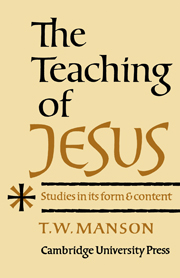Book contents
- Frontmatter
- Contents
- Preface
- LIST OF ABBREVIATIONS
- PART I PRELIMINARY QUESTIONS
- Chap. I Introduction: Problems and Methods
- Chap. II The Sources
- Chap. III Formal Characteristics of the Teaching
- Detached Note A. On Mt. xii. 28; Lk. xi. 20 (Q)
- Detached Note B. The Parable of the Wedding Feast (Mt. xxii. 1–14)
- PART II THE CONTENTS OF THE TEACHING
- Appendices I–VI
- Additional Notes
- General Index
- Reference Index
Chap. III - Formal Characteristics of the Teaching
Published online by Cambridge University Press: 31 March 2010
- Frontmatter
- Contents
- Preface
- LIST OF ABBREVIATIONS
- PART I PRELIMINARY QUESTIONS
- Chap. I Introduction: Problems and Methods
- Chap. II The Sources
- Chap. III Formal Characteristics of the Teaching
- Detached Note A. On Mt. xii. 28; Lk. xi. 20 (Q)
- Detached Note B. The Parable of the Wedding Feast (Mt. xxii. 1–14)
- PART II THE CONTENTS OF THE TEACHING
- Appendices I–VI
- Additional Notes
- General Index
- Reference Index
Summary
THE linguistic problem raised by the Synoptic Gospels involves three distinct questions: (i) What was the language in which the Gospels were composed? (2) What is the original language of the sources which lie behind the Gospels? (3) Seeing that the Gospels all record speeches and dialogues, in what language were these utterances spoken? It is the third of these questions that most closely concerns us in the present enquiry. As to the first, it is now definitely answered, so far as Matthew and Luke are concerned, by the fact that both Gospels make use of our Greek Mark. They are therefore to be regarded as Greek compositions. Mark is still generally regarded as a Greek work, though Wellhausen argued for Aramaic and, more recently, Dr P.-L. Couchoud thinks of this Gospel as originally composed in Latin. The second question is more difficult. Seeing that the ‘Ur-Marcus’ theory is now discredited, there is no longer any reason to suppose that the source Mk differed in any important respect from our Mark: and consequently any conclusion reached as to the original language of the Gospel will hold of it qua source. If Q, be the document referred to by Papias, it follows that it was originally composed in a Semitic dialect–probably Aramaic–and we have already seen that there are some grounds, apart from the testimony of Papias, for supposing this to be the case. With regard to M and L we are left largely to conjecture.
- Type
- Chapter
- Information
- Teaching of Jesus , pp. 45 - 81Publisher: Cambridge University PressPrint publication year: 1935

